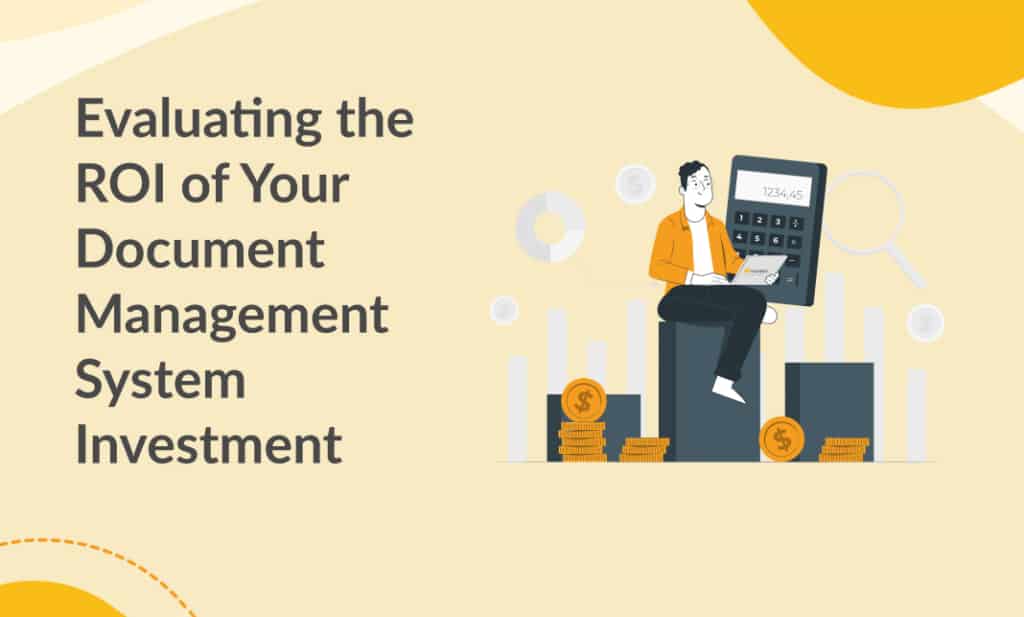Investing in a Document Management System (DMS) is a strategic decision that can significantly impact your organization’s efficiency, productivity, and bottom line. One of the key factors to consider when investing in a DMS is the Return on Investment (ROI). This article will guide you on how to evaluate the ROI of your DMS investment using Folderit’s pricing as our benchmark.
Understanding Document Management Systems
A Document Management System (DMS) is a software solution that allows organizations to capture, store, manage, track, and share electronic documents and files. A DMS provides a centralized location for all business-critical documents, which can be accessed and managed easily from any location. It enables organizations to automate document workflows, enforce compliance, and reduce manual errors.
Folderit offers a robust and intuitive DMS that aligns with these functionalities. It provides features such as document approval workflows, custom metadata fields, versioning, and reminders, among others.
Measuring the ROI of a Document Management System
The ROI of a DMS can be measured by calculating the financial benefits that the system delivers, divided by the initial investment. Here are some of the key metrics that can be used to calculate the ROI of a DMS:
- Cost Savings: By reducing the manual processing of documents and automating document workflows, organizations can save significant costs associated with printing, copying, scanning, and storing paper documents.
- Increased Efficiency: A DMS can help organizations streamline their document management processes, resulting in improved efficiency. The time saved in document processing can be calculated by comparing the time taken to process documents manually versus the time taken to process them using the DMS.
- Improved Collaboration: A DMS enables employees to collaborate effectively on documents, even if they’re located in different parts of the world. By reducing the time taken to collaborate and improving communication, organizations can improve productivity and increase revenue.
- Improved Compliance: Compliance is critical for many organizations, particularly in regulated industries. A DMS can help organizations ensure compliance by enforcing security and access controls, tracking document versions, and providing audit trails.
- Reduced Risk: A digital document management system can reduce the risk of data breaches and loss of critical information. By providing secure access to documents, ensuring compliance with regulations, and enabling disaster recovery, organizations can mitigate the risk of data loss.
- Improved Customer Service: A document management system can help organizations respond to customer inquiries faster and more accurately. By providing employees with quick access to customer documents, organizations can improve response times and customer satisfaction.
- Increased Revenue: A quality document management system can enable organizations to increase their revenue by improving efficiency, collaboration, compliance, risk management, and customer service.
Calculating the ROI of Your Document Management System
Let’s take Folderit’s Medium plan as an example, which costs $81 per month. Assuming the total cost of implementing the system is $972 for a year (12 months * $81), and the system results in a time savings of 5 hours per week for each of the 10 users who use the system, and that each employee’s hourly rate is $50. This results in a weekly cost savings of $2,500, or $130,000 per year. The ROI would then be calculated as follows: ROI = ($130,000 – $972) / $972 ROI = $132. This means that for every dollar invested in the Folderit document management system, the company can expect to see a return of $132.
The Math in Detail for Nerds Who Care
Total Cost Savings Per Year Calculated:
The total cost savings per year is calculated based on the time saved by using the Folderit system and the hourly rate of the employees.
In the example provided:
- Each of the 10 users saves 5 hours per week by using the Folderit system. So, the total time saved per week is 5 hours/user * 10 users = 50 hours.
- If each employee’s hourly rate is $50, then the cost savings per week is 50 hours * $50/hour = $2,500.
- To calculate the total cost savings per year, we multiply the weekly savings by the number of weeks in a year (assuming the system is used throughout the year): $2,500/week * 52 weeks/year = $130,000/year.
- So, the total cost savings per year due to the time saved by using the Folderit system is $130,000.
ROI Calculated:
The return on investment (ROI) is calculated as follows:
ROI = (Net Profit / Cost of Investment) * 100
In this case:
- Net Profit is the annual savings from using the Folderit system, which is calculated as the total cost savings per year ($130,000) minus the annual cost of the Folderit system ($972).
- Cost of Investment is the annual cost of the Folderit system ($972).
So the calculation becomes:
ROI = (($130,000 – $972) / $972) * 100 = 132.79%
This means that for every dollar invested in the Folderit document management system, the company can expect to see a return of $1.33 (rounded to the nearest cent).
The Cost of Transition to a Cloud-Based DMS
When transitioning from an on-premise or physical document management system to a cloud-based DMS like Folderit, there are several cost factors to consider. These include:
- Cost of Physical Document Management: This includes costs associated with physical storage space, paper, printing, and manual labor involved in filing, retrieving, and managing documents. It also includes costs related to security, such as locks and surveillance for physical storage areas.
- Cost of On-Premise DMS: If you’re transitioning from an on-premise DMS, costs include server hardware, software licenses, maintenance, and IT staff to manage the system.
- Cost of Folderit DMS: This includes the subscription cost of Folderit’s Medium plan ($81 per month or $972 per year).
- Cost Savings: Transitioning to a cloud-based DMS can result in significant cost savings. These include reduced physical storage and printing costs, reduced labor costs due to automation, and reduced IT costs. Additionally, cloud-based DMS like Folderit offer benefits such as remote access, scalability, and improved collaboration.
Let’s assume that the annual cost of physical document management or on-premise DMS is $50,000, and the company can reduce these costs by 50% by transitioning to Folderit. The net income (cost savings) would be $25,000 per year.
Using the ROI formula:
ROI = (Net Income / Cost of Investment) x 100
ROI = ($25,000 / $972) x 100
ROI = 2572.02%
This means that for every dollar invested in the Folderit document management system, the company can expect to see a return of $25.72. This demonstrates the significant ROI potential of transitioning from a physical or on-premise document management system to a cloud-based DMS like Folderit.
The Strategic Advantage of Folderit’s Document Management System
Folderit’s DMS is not just a tool; it’s a strategic asset that can transform your organization’s document management processes. With its robust features and user-friendly interface, Folderit makes document management a breeze. Its advanced search functionality, powered by Optical Character Recognition (OCR), makes finding documents quick and easy. The system’s ability to handle multiple file versions ensures that you always have access to the entire history of a document, enhancing accountability and transparency. Moreover, Folderit’s dedicated email address for every account role allows for easy document saving on the go. The system also offers secure document storage, ensuring that your data is encrypted and safely stored in the cloud. With Folderit, you’re not just investing in a DMS; you’re investing in the future of your organization.
Choose the Right DMS for Maximum ROI
Measuring the ROI of a document management system is critical for any organization seeking to improve its operational efficiency and reduce costs. By implementing an effective DMS like Folderit, companies can streamline their processes, increase productivity, and reduce errors and compliance risks. The tangible ROI, as demonstrated in the example above, shows the significant financial benefits that can be achieved with a strategic investment in a DMS.



